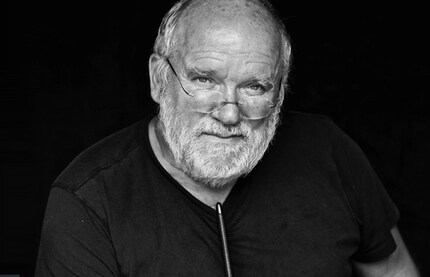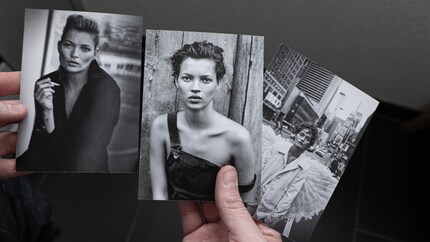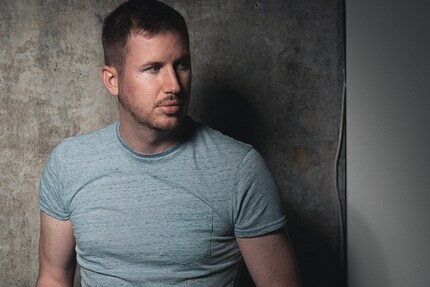
Background information
She didn't want to make hidden object books, now she owns the genre
by Ann-Kathrin Schäfer

Digitec Galaxus photographer Thomas Kunz explored the life and work of Peter Lindbergh in a four-episode documentary, created with filmmaker Armin Tobler. In this interview, they talk about how the series came to be and what they’ve learned in the process.
One is the photographer and protagonist of the documentary, the other is the director, editor and the man behind the camera. Thomas Kunz and Armin Tobler are part of the Digitec Galaxus editorial team. The team, which counts 28 employees, provides online shop visitors with daily news, inspiration and information.
Most of the time, the two – I’ll just call them Kunz & Tobler – spend their days taking authentic photos for reportages or editing video reviews. But in the past few months, they’ve also taken the time to work on a very special project that presented them with special challenges.
Thomas, the photographer, let Armin, the filmmaker, accompany him on his quest to find out if – and how – the great photographer Peter Lindbergh could be an inspiration in developing his own style. The grandmaster of photography passed away in 2019.
Thomas, if Peter Lindbergh were alive today and you could meet him, but only had time for one question, what would you ask him?
Thomas: (thinks for a long time) Good question. Well, he travelled a lot as a young man and worked a lot. I would probably ask him at what point he decided to become a photographer – when it «clicked» for him. At what point his passion began.
The readers already know you both have a fascination with Peter Lindbergh. But how did you come up with the idea for this project?/
Thomas: It was actually almost out of necessity. In the first lockdown, I suddenly had much fewer photo assignments. So, I started thinking about what else I could do. We started by publishing a collection of photography tips for our readers.
That’s why you went for episodes instead of a full-length documentary?
Armin: Yes, exactly. We wanted to keep people on our journey for as long as possible – the Netflix principle, so to speak. Funnily enough, people will binge-watch a series for nine hours straight. But a nine-hour sci-fi documentary by Steven Spielberg – that’s somehow too much. That’s why we decided to split our documentary into episodes.
A serendipitous turn of events. And how did you go about the project? Did you suddenly have to learn how to be the main actor, Thomas?
**Thomas: ** There was definitely a learning curve. I’ve been working for Digitec Galaxus for eight years now, but I’ve never learned so much in such a short period of time as I did through this project. I’m glad I had Armin by my side.
Why’s that?
Thomas: He made me write an essay about myself as a photographer, for example. Where do I currently stand as a photographer? Where do I want to go? How can we make sure I get there?
And then Peter Lindbergh came into the picture?
We thought about what actually makes a photographer and what makes any photographer’s work superior? Peter Lindbergh has been one of my idols ever since I saw an exhibition of his in Munich in 2016. There’s this one photograph that I to this day can’t get out of my head. I also started recognising his other work just by the style.
Armin, were you also familiar with Peter Lindbergh?
Armin: No, I wasn't. But when Thomas introduced me to his work, it was immediately clear that his style and quality are miles ahead of Instagram photos. This also made it more challenging, though. At the beginning, we invested a lot of time into learning about him. After all, we figured whatever we produce should be up to his standards.
And how close did you ultimately get to Peter Lindbergh as a person?
Thomas: Quite close. I think if I could meet him, I would already have an idea of what makes him tick. We’ve received many compliments on how well we portrayed him and understood his art. An assistant who had worked for him for seven years confirmed our analyses were accurate. In my eyes, that was the greatest compliment we could have received.
In the end, how many people did you contact during the research phase?
Thomas: Four.
What is she like?
Thomas: Like an open book. And she really did a lot to help us create something worthwhile.
The project is the result of a joint effort. How was the experience of working together?
Thomas: Armin and I have become a true team. But the others also felt like part of the team – be it Renata, the make-up artist, or Alejandra, our model from Episode 4. That was also the only time we were physically all in one place.
Thomas, you’ve just spent a lot of time trying to figure out your own style. What tips can you share with fellow photographers?
Thomas: One of the most important things I learned is that you shouldn’t be afraid to assert your own style. You don’t have to want to be anyone else. You have to stay true to yourself and to your style.
And if you haven’t yet found your own style?
Thomas: Be patient. Just keep at it, and you'll find it in your own time. And don’t start obsessing over any Instagrammers.
Is that your leitmotif – the «man on a mission»?
Armin: Absolutely. I have the impression that technology is significantly changing people – whether it’s the algorithm in our store or something like Instagram. In terms of film, I’d like to go back to realism, away from the staged style that started in Hollywood and has now flooded social media.
So there’s presently not yet enough of this realism?
Armin: In this day and age, anyone can put anything on the Internet whenever. And the person who shouts the loudest has the greatest chance of being heard. And that’s rarely genuine.
So it’s essentially a world of make-believe?
Armin: Yes. But what I unfailingly find more interesting is what happens behind the scenes. It’s not this one brief moment that’s so exciting; it’s everything surrounding it. And that’s what Peter Lindbergh has always brought across so authentically.
Those are very nice closing remarks. Armin, Thomas, thank you for the interview.
Did you miss the series? No problem – here are all four episodes of the Kunz & Tobler documentary:
Do you feel inspired to grab your camera? If so, we have just the thing for you: a photography challenge! You have until 9 July 2021 to send in your black and white portraits, and you might even win a prize. Click here for all the details.
Journalist since 1997. Stopovers in Franconia (or the Franken region), Lake Constance, Obwalden, Nidwalden and Zurich. Father since 2014. Expert in editorial organisation and motivation. Focus on sustainability, home office tools, beautiful things for the home, creative toys and sports equipment.
Interesting facts about products, behind-the-scenes looks at manufacturers and deep-dives on interesting people.
Show all
How did they like that?
Thomas: It was good. But I did tell Armin that we can’t do just this forever. After all, it only scratches the surface. And right around that time, Tommy also wanted to see a new type of content. (Editor’s note: Tommy is the leader of the social and video team and therefore Thomas’ and Armin’s boss.) In the end, it was Armin who got the ball rolling.
Armin: I’d like to add that it’s not a proper documentary. In the past, people might have been willing to sit in a cinema for 90 minutes to watch this kind of film. But we now live in the age of social media. Everything has to be shorter.
Alright, so you wanted to test a new form of content. But, in addition to that, you did also want to give viewers something worth pondering, didn’t you?
Armin: Definitely. I personally found it interesting to see how we, as humans, are wired and how we deal with technology. Of course, we work with technology all the time at Digitec Galaxus. But to me it’s also about who I am as an artist; where I currently am and where I want to go. And, in this specific case, it’s about Tom wondering if he’s even good enough. Capturing this in a documentary, diving into the life of a person, getting a behind-the-scenes look... it’s one of the most special experiences you can have.

So what came first: the idea for a documentary or the question on Thomas’ mind?
Thomas: I had already been aware of the fact I don’t have a distinct style for a while. But the coronavirus pandemic did make me think about it even more. So I asked Armin to send me a list of the best documentaries he knows. I watched a lot of them. «Finding Vivienne Meier» was especially moving. I thought to myself that in five years’ time we could do something similar. And then it ended up happening faster than expected.

How difficult was it to find people who wanted to talk openly with you about Peter Lindbergh?
Thomas: Alex Falba served as our starting point – we had interviewed her for Galaxus sometime in 2020. (Editor’s note: you can find the interview here.) I remembered her telling me she had worked with Peter Lindbergh. So I got in touch with her and asked for help. She recommended I speak to Christophe Starkman, who worked as a producer for Lindbergh. He agreed to participate in the project, but ended up having to cancel. He then referred me to Stefan Rappo – the longtime assistant to Lindbergh I mentioned before. I found his phone number on the Internet and wrote him a message on WhatsApp. He himself didn’t want to be in front of the camera, but he recommended we get in touch with Nina.
What impressed you most in the conversations you had?
Thomas: There’s this preconception that famous people are always super busy and arrogant. I was surprised that everyone was friendly and made the time to talk to us. Christophe Starkman did actually say he didn’t have much time; yet he sent me a very long, detailed response to my question. There’s also Nina Burri. I had seen her on TV and knew her as the ‘Snake Woman’. But I had no idea what she was like in real life.
Peter Lindbergh died before the most recent wave of staged photos on Instagram – maybe that's for better. I wonder what he would have to say about this type of photography if he were still alive...
Thomas: I suspect he wouldn’t give a flying flip about it and would just keep doing his thing. He never cared much for trends and conventions. When he was hired in 2017 to shoot the famous Pirelli Calendar, he didn’t choose young models from the fashion industry as the subjects. Instead, he chose older women who have seen and experienced more in their lives. He also didn’t have them pose nude, as was standard up to that point. He depicted the women in a series of powerful portraits.

And what would the man behind the camera like to add, Armin? Have we reached the end of this documentary journey? Or can we expect future episodes with Thomas?
Armin: Well, you never really reach the end. That’s the nice thing about documentaries. Maybe we’ll find a new journey to go on with Thomas in the future. Or with you, Martin. Or anyone else from the editorial team, for that matter. The question of who you currently are and who you want to be is universal. The important thing is the person at the core of it – so, what they do with technology, not what technology makes of them.